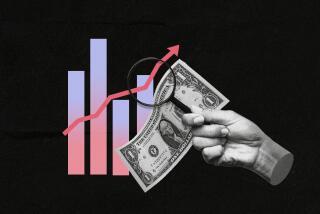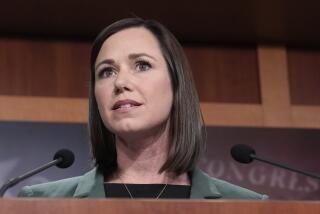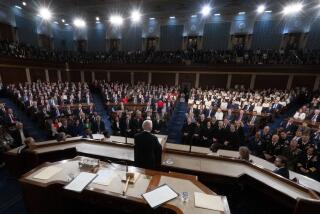Obama’s speech to focus on income inequality and social mobility
- Share via
In his State of the Union address Tuesday night, President Obama will try to recharge his presidency by discussing the expansive divide between rich and poor in America.
It’s a crucial issue, and one with no easy solutions.
Obama is expected to focus on the twin themes of income inequality and social mobility, which is the ability to move up the economic ladder.
Wealth disparity has drawn enormous attention with the U.S. income gap at its highest level since the Great Depression. A study last week found that the 85 richest people in the world have the same amount of wealth as the bottom half of the global population.
The richest 1% of U.S. households — those making at least $394,000 a year — have been helped by surging stock prices and a recovering housing market. The rest of the country has grappled with stagnant wages, a phlegmatic job market and wearisome student debt.
“The rich keep getting richer and the middle and the poor are just sort of staying still,” said Melissa Kearney, a senior fellow at the Brookings Institution in Washington. “All the income and productivity gains we’ve experienced in this country are going to the folks at the top.”
What Obama is unlikely to dwell on in his speech, however, is that inequality and mobility have vexed the U.S. economy for more than 30 years. There are no easy solutions for reversing the trends.
Obama has pushed measures that backers say could boost the well-being of lower- and middle-class Americans. That includes a hike in the minimum wage and broad access to preschool.
But that would do little to offset the effects of globalization and technological progress, which have done away with lower-skilled jobs even as they have put a premium on highly educated workers.
Entrenched social forces, such as the increase in single-parent homes among low-income people and the increasing tendency of the highly educated to marry one another, exacerbate wealth and mobility trends, experts say.
“There really is no silver bullet to enhancing economic mobility,” said Erin Currier, who studies the issue at the Pew Charitable Trusts. “It isn’t going to be any easy one-off solution. A host of things matter, and they matter simultaneously.”
The debate over inequality has been muddied by Americans’ mixed feelings about wealth.
Popular sentiment long has held that inequality is an unpleasant but unavoidable byproduct of capitalism. There was fear that tackling inequality could stifle economic innovation or penalize the wealthy for diligence and resourcefulness.
The relative good fortunes of the so-called upper-middle class also come into play.
It takes a $1.9-million annual income for a household to qualify for the top 0.1%, according to research by Emmanuel Saez at UC Berkeley and Thomas Piketty at the Paris School of Economics.
But it takes only $114,000 to make it into the top 10%, and $161,000 to be in the top 5%. That’s easily within reach for dual-income households in lucrative fields such as medicine, finance or law.
“People I know and work with talk about the top 1%,” Kearney said. “And I say, ‘Let’s be clear, you’re the top 5%.’”
The slack economic recovery and heaping prosperity of the affluent have begun to shift perceptions.
Two in three Americans are dissatisfied with the nation’s income and wealth distribution, according to a Gallup poll last week. And 45% express doubt about the ability to get ahead through hard work, twice the level of 2002.
Inequality has increased dramatically in the last three decades.
The average income of the top 1% surged 275% from 1979 to 2007, according to government data. It rose only 18%, however, for the bottom fifth of the population.
A key issue is whether low- and middle-income people can climb the economic ladder.
A study last week co-written by acclaimed Harvard economist Raj Chetty found that economic mobility has remained roughly the same over generations.
But mobility in the U.S. is considerably lower than in most other developed countries, Chetty said.
An analysis by Pew’s Economic Mobility Project found that only 4% of people raised in the bottom one-fifth of the U.S. income scale made it to the top fifth.
Seven in 10 people raised in the bottom rung couldn’t even reach the middle class, according to the study.
“It’s good news that mobility has not gotten significantly worse, but it’s still a concern that mobility is not that high in the U.S. and it hasn’t been over the past 30 years,” Chetty said.
People such as Aime Ndondo hope the rags-to-riches story is still within reach.
A native of the Democratic Republic of Congo, Ndondo, 28, is a personal trainer at Gold’s Gym in downtown Los Angeles. But he’s studying computer science at a community college and is optimistic about his future.
“The American dream is alive, but you need to work hard and know what to study,” Ndondo said.
Still, some experts worry about the long-term effects of inequality.
“One of things that worries me is that as the top pulls away we have an increasingly segregated society by income class,” Kearney said.
“College-educated folks are marrying each other, they’re showering advantages on their kids,” she said. “And on the lower end, you have kids who have less-educated parents. They’re more likely to have single parents. They’re less likely to have any connections to the middle class.”
More to Read
Inside the business of entertainment
The Wide Shot brings you news, analysis and insights on everything from streaming wars to production — and what it all means for the future.
You may occasionally receive promotional content from the Los Angeles Times.











